Sin Maíz No Hay Vida (Without Corn There Is No Life) – a report from Chiapas by Brian Batchelor
November 7, 2013
On August 14, 2013, a press release from Monsantoglobal.com announced to media outlets across the world that Mexico’s Secretariat of Agriculture (SAGARPA) had approved permits for the company to plant more than a quarter-of-a-million hectares of GMO corn across Mexico. The release also announced two Monsanto-funded cultural initiatives in response to Mexico’s certain loss of ecological and cultural diversity due to the introduction of genetically-modified monocrop culture: first, the creation of a seed bank preserving Mexico’s 246 strains of native corn, and, second, an online museum preserving Mexico’s rich cultural heritage. According to Monsanto’s press release, this digital archive, named the Codex Mexico after the Mayan manuscripts that were lost during Conquest, will allow future generations to know more about contemporary Mexican life and culture than current anthropologists, archeologists and historians know about Mexico’s pre-Columbian peoples. “Never again,” Monsanto states, “will the wealth of this region’s culture be lost as social conditions change.”
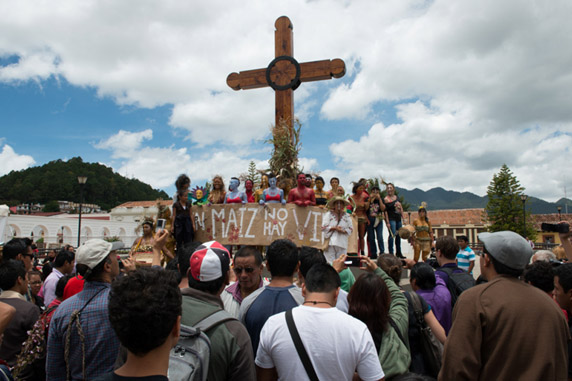
Later that day, a second press release was sent out over the wire, this time from Mosantomedia.com, denouncing the initial release as a hoax perpetrated by an online digital activist group called Sin Maize No Hay Vida, and decrying the lies and misinformation spread by the activists across the Internet. The release noted that, while Monsanto expected SAGARPA to approve their permit to plant 440 000 hectares of genetically modified corn across northern Mexico, no decision had yet been made. In this release, Monsanto also mentioned that although they recognize the importance of Mexico’s cultural and biological heritage, ultimately GM corn leads to an increase in a farmer’s production of wealth and economic sustainability by decreasing the plants, insects and animals that reduce corn yields. Indeed, GM corn even increases biodiversity by introducing a new corn species to Mexico’s diverse corn crop!
Both press releases were the brainchild of Sin Maize No Hay Vida, a collaborative activist group composed of (in no particular order) one part Yes Lab, one part Hemispheric Institute for Performance and Politics, one part La FOMMA, one part Jesusa Rodríguez, and many parts of students, researchers, artists and activists. Although these press releases were fictional, Monsanto’s request for a permit to plant 440 000 hectares of transgenic corn in Northernr Mexico was very real, and currently under consideration by Mexico’s Secretariat of Agriculture. These press releases were the digital half of a larger acción intending to raise public consciousness of Monsanto’s application and to highlight the stakes were Monsanto and other corporations to privatize this important crop. The other half of this initiative was a Carnaval del Maíz (Carnival of Corn): a live acción performed in a main square in in San Cristóbal de las Casas, Chiapas, also on August 14, 2013.
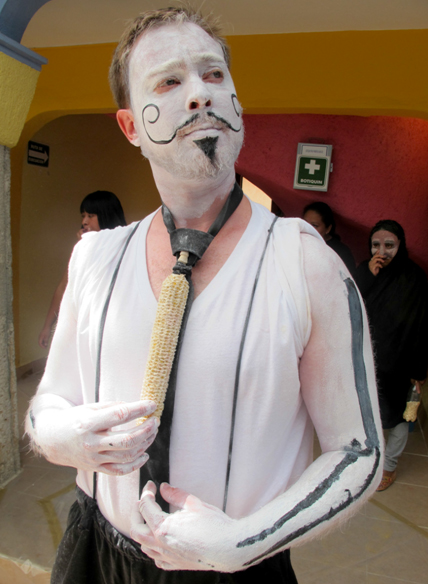
I participated in both the digital and live public performances as part of the Art and Resistance course coordinated through the Hemispheric Institute of Performance and Politics and New York University. I curated photos for Monsanto’s Codex Mexico as part of the digital acción, and I painted my face and arms and performed in the live acción. We based our performance on the Popol Vuh, a Mayan myth/legend that deals with the origins of the Maya peoples, as well as that of corn. In it, two ballplayers, Hun Hunahpu and Vucub Hunahpu, are summed to Xibalba, the underworld, where they are defeated and sacrificed. However, in his death, Hun Hunahpu brings his two twin sons into creation; they are saved from the underworld but are themselves eventually summoned back to play the ball game. This time, they defeat the lords of the underworld and transform into the sun and the moon, overseeing the creation of life from corn.
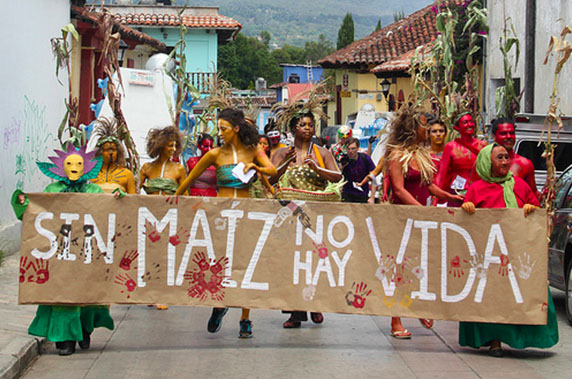
The live acción was facilitated by notable Mexican performance artist, Jesusa Rodríguez. We performers split into two teams based on the Popul Vuh: Hunahpu, the people of the corn (who you primarily see above), and Xibalba, here representing Monsanto. Two performers, who happened to bear a striking resemblance to each other, represented the hero twins (seen at centre in the photo above). I was a member of team Monsanto – hence my Guy Fawkes-esque face paint and corncob tie. We began our performance with a march the main square in central San Cristóbal, hoping to attract an interested audience. The people of the corn led the way, and we members of Xibalba followed. About halfway there, once the streets got busier and more crowded, we started chanting and dancing choreographed interactions and enactments as we moved, bringing more attention to our performance. For example, the photograph below shows team Monsanto preparing to line-up single file and march in synchronized order while conversing intently on our imaginary cell phones.
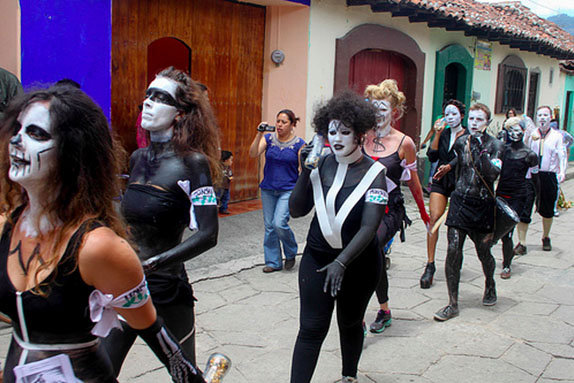
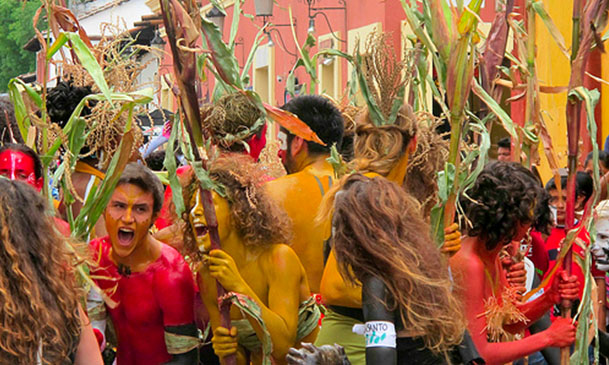
We also choreographed moments between the two groups when, on a vocal cue, team Monsanto would encircle the children of the corn. Those of us representing Xibalbha/Monsanto would attempt to infiltrate the people of Hunahpu and steal their corn from them while they would fight us off with their cornstalks. We alternated these rehearsed moments en route to our final destination: the plaza located west of San Cristóbal’s cathedral. Upon arriving in the square, the children of the corn formed a circle with their cornstalks and, placing them down on the ground, demarcated a playing space. Within this circle, we enacted our own take on the ancient ball game: the people of the corn versus Monsanto in a game of Dodgeball. Prior to commencing our game, Jesusa described to the crowd the rules of the game (although I expect that many of them already knew) and outlined the two sides fighting. Members of the crowd were invited to join either of the two sides, although none joined team Monsanto.
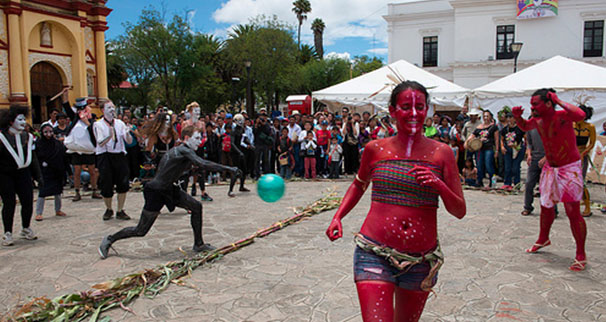
The Dodgeball game was intense, with the children of the corn’s superior numbers clearly giving them the upper hand. But Team Monsanto then went on a run, catching the ball a number of times in a row while striking out some of Team Hunahpu’s strongest players. Nevertheless, since Team Hunahpu had more players and clear support from the crowd, Team Monsanto were slowly whittled down, one by one, until one last player was left. She remained in the game, dodging ball after ball tossed her way by Hunahpu players. Then, perhaps a better ending to this performance than anyone could have guessed occurred: a younger girl who had joined the children of the corn from the crowd got the ball and ended the game by hitting the last Monsanto player. The pictures below captures the moment right before this event and the winning celebrations.
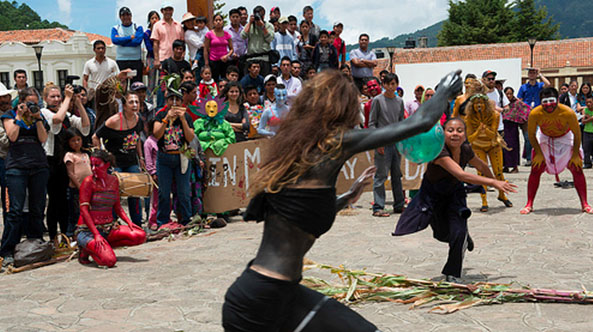
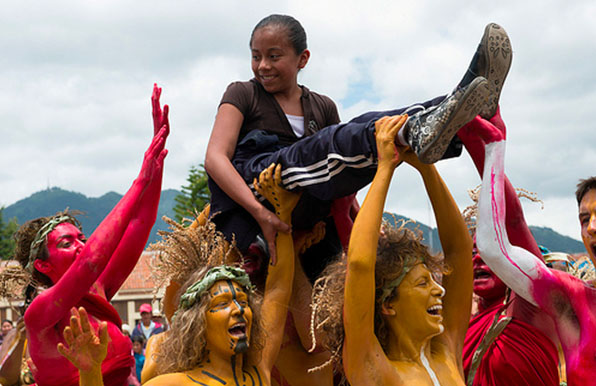
After the game we gathered around a central dais in the square, the vanquished Monsanto team below and the victorious children of the corn above. Using human microphone technologies, Jesusa (on the right, wearing the sunhat) communicated to the crowd information on Monsanto’s proposal to introduce vast quantities of GMO corn in Mexico. This was a consciousness-raising project: an attempt to educate passers-by – citizens and tourists, locals and visitors – about Monsanto’s permit, and an attempt to connect Mexico’s cultural heritage to its rich biological diversity.
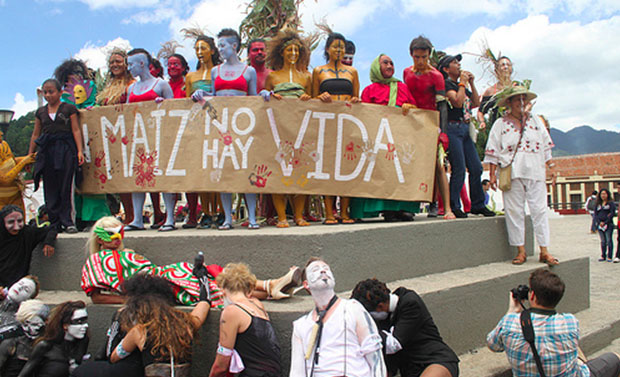
On October 10, 2013, Judge Jaime Eduardo Verdugo J., of the Twelfth Federal District Court for Civil Matters of Mexico City, suspended transgenic corn plantings in Mexico, ruling that the genetically-engineered corn posed “the risk of imminent harm to the environment.” The judge further banned multinational corporations such as Monsanto and Pioneer from releasing transgenic maize in Mexico while several civic lawsuits against these companies were working their way through Mexican courts. This court ruling forces SAGARPA to immediately halt all activities involving granting permits to plant, as well as the act of planting transgenic corn in Mexico. This is a major, albeit temporary, step in preventing privatization of Mexico’s maize by multinational agribusiness and protecting Mexico’s rich agrobiodiversity.
Brian Batchelor is a second-year PhD student in Theatre and Performance Studies at York University. His research focuses on how performances within tourist encounters in Mexico shape and are shaped by both transnational and local concerns. He is interested in whether this dualistic dynamic opens up a space for what he call de-tours: moments of autoethnographic representations and/or de-colonial encounters that problematize dominant and unidirectional touristic relations and desires. He is also interested in the slippages between researcher and tourist as well as the importance of critically reflexive autobiographical travelogue in understanding his own encounters as a tourist-researcher in these places.
